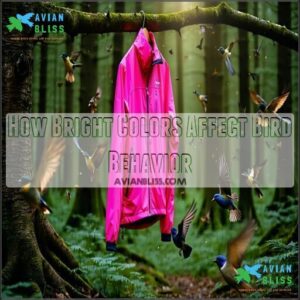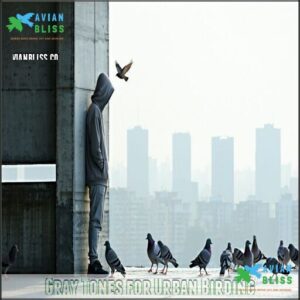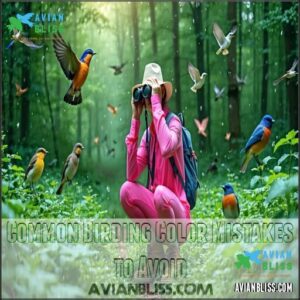This site is supported by our readers. We may earn a commission, at no cost to you, if you purchase through links.

White and reflective fabrics are also a no-go since they catch the light and disrupt birds’ natural behavior. Instead, stick to earthy tones like olive green, brown, and gray to blend into the environment and keep birds at ease.
Think of it as dressing for a nature-themed spy mission—low profile is key! Avoid shiny accessories or high-contrast patterns, as they can be distracting.
Want to spot more birds without scaring them off? Your outfit matters more than you think, and choosing the right colors is key to a successful birding experience.
Table Of Contents
- Key Takeaways
- Colors to Avoid Birding
- Earthy Tones for Birding Success
- Birding Attire for Different Environments
- Tips for Wearing Bird-Friendly Colors
- Common Birding Color Mistakes to Avoid
- Frequently Asked Questions (FAQs)
- What colors do birds avoid?
- What is the best clothing for bird watching?
- What are the 5 S’s of birding?
- What colors should you wear when birding in a desert?
- How do colors affect birds?
- Why do birders not wear white?
- What colors do birds like?
- What colors should you wear for birding?
- What should I wear if I’m a birder?
- What color do birds avoid?
- Conclusion
Key Takeaways
- Don’t wear bright colors like red, yellow, or neon—they alarm birds and trigger their flight instincts.
- Skip white clothing and reflective materials as they catch light and signal danger to birds.
- Stick to earthy tones like olive green, brown, and gray to blend into the environment and stay unnoticed.
- Avoid shiny accessories or high-contrast patterns that disrupt birds’ natural behavior.
Colors to Avoid Birding
When you’re birding, wearing the wrong colors can send birds into hiding before you even spot them.
Bright shades like white, neon, or reflective fabrics stand out unnaturally, signaling danger and disrupting their natural behavior.
Bright Colors to Steer Clear Of
During your birding adventures, bright colors act like alarm bells that send birds scattering before you can even focus your binoculars.
When birds detect vibrant shades in their environment, their natural predator avoidance instincts kick in immediately.
Specific colors to avoid include:
- Red, yellow, and orange – These bright colors startle many bird species, causing them to flee or hide.
- Electric blue and bright greens – These unnatural shades don’t blend with surroundings and signal potential danger.
- Shiny fabrics and metallic finishes – These reflect UV light that birds can see intensely, making you highly visible.
Even your laundry choices matter – detergent brighteners can make neutral clothes unexpectedly bright to birds’ sensitive vision.
The neon impact of fluorescent colors is particularly problematic, as they don’t exist naturally in most habitats.
Remember, colors scare birds when they break the camouflage patterns they’ve evolved to recognize.
Why White is a No-Go for Birding
While bright colors can startle birds, white might be the biggest culprit in your birding wardrobe.
White clothing is like a flashing danger sign to birds, disrupting their peace and sending them into retreat.
Beyond just standing out, white creates problems through high visibility and reflected sunlight, sending birds into full retreat mode.
| Impact of White | Better Alternative |
|---|---|
| High visibility | Olive green |
| Reflected sunlight | Brown tones |
| Perceived threat | Gray shades |
| Bird disturbance | Muted blues |
| Unnatural presence | Tan/beige |
Birds actually perceive white as a danger signal – it’s like wearing a "predator here!" sign.
You’ll dramatically improve your chances of close encounters by swapping white clothing for earth tones that blend naturally into your surroundings.
To help guarantee their safety, consider maintaining a distance from birds.
Neon Shades to Leave Behind
While white clothing raises alarm bells for birds, neon shades are possibly even worse for your birding adventures.
Those electric blues, fiery reds, and fluorescent yellows that light up your wardrobe should stay home when you’re heading out to spot birds.
The science is clear – birds have excellent color vision, and neon shades fall outside their natural environment’s color palette.
These artificial colors create what scientists call "UV reflection danger," making you stand out dramatically against natural backgrounds.
Even laundry detergent brighteners can increase your visibility range to birds.
- Wearing neon colors triggers bird stress signals similar to those caused by approaching predators
Ethical color choices mean understanding how your appearance affects wildlife.
Instead of those eye-catching neon fabrics, opt for muted tones that help you blend in.
Your binoculars might be your most important birding tool, but your clothing color choice comes in a close second.
How Bright Colors Affect Bird Behavior
While neon colors may brighten your day, they signal danger to our feathered friends.
When you wear bright colors during your birding excursions, you’re triggering bird stress and predator avoidance instincts.
Birds have superior color vision to humans and interpret these alarming colors as visual threats.
Your fluorescent jacket or vibrant hat causes behavioral disruptions, making birds flee before you can observe them.
These avian reactions aren’t personal – birds naturally associate bright shades with potential danger, similar to how predators stand out in nature.
Earthy Tones for Birding Success
You’ll dramatically improve your bird sightings when you dress in natural earth tones like olive green, brown, and gray that blend seamlessly with the environment.
These subdued colors help you disappear into the landscape, allowing birds to maintain their natural behaviors while you observe them without causing stress or triggering their flight response, which is crucial for successful bird watching.
Olive Green for Blending In
Olive green stands as the ultimate champion among birding clothing colors, offering seamless integration with natural surroundings.
This versatile shade mimics foliage perfectly, allowing you to disappear into the landscape while birds continue their natural behaviors undisturbed. When you’re wearing olive green, you’ll notice birds act more authentically, as they don’t perceive you as a threat.
Three key olive green benefits include:
- Perfect camouflage – Blends with various vegetation types across seasons
- Psychological advantage – Creates less visual disruption than other earthy tones
- Year-round utility – Works in spring, summer and fall environments
Unlike alternatives like sage or forest green, true olive provides superior concealment in most habitats. It’s particularly effective during summer and fall when foliage creates dappled light conditions.
Finding the right apparel can be easy as you shop olive clothing. Consider investing in quality olive apparel—you’ll dramatically improve your birding experience through better camouflage.
Brown Shades for Camouflage
Embracing brown shades creates perfect bark mimicry when you’re birding. From rich chocolate to light taupe, these natural colors help you blend seamlessly with forest floors and tree trunks.
Seasonal browns vary by environment – darker tones work best in dense woods, while lighter soil camouflage suits open areas.
The beauty of birding camouflage is in its simplicity – browns don’t reflect light or catch birds’ attention. By wearing these earthy hues, you’ll become practically invisible, letting wildlife continue their natural behaviors undisturbed.
You can even find various camo patterns designed for ideal concealment. It’s amazing how shade variation in brown clothing improves your chances of close encounters.
Gray Tones for Urban Birding
While browns work wonderfully in forests, cities call for a different approach.
Gray tones offer perfect concrete camouflage for urban birding adventures.
Various gray variations – from charcoal to slate – help you disappear against buildings and shaded areas.
Urban habitats demand strategic blending strategies.
You’ll become practically invisible in gray clothing when watching city birds.
- Feel the thrill of a sparrow landing just feet away, unaware of your presence
- Experience the joy when pigeons don’t scatter as you approach
- Notice the confidence that comes with proper birding camouflage
- Enjoy the peaceful connection with wildlife that trusts your presence
How Earthy Tones Improve Birding Experience
While urban birders benefit from gray tones, your birding experience transforms completely when you embrace the full spectrum of earthy tones.
These natural shades reduce bird stress substantially, creating a peaceful environment for both you and your feathered subjects.
When you wear earthy tones, you’ll notice:
- Birds continue natural behaviors instead of fleeing
- More opportunities for close-up observation without disturbing wildlife
- Extended viewing times as birds don’t perceive you as a threat
- Better photo opportunities with relaxed, natural subjects
- A stronger connection to the environment you’re exploring
The natural blending these colors provide isn’t just about seeing more birds—it’s about witnessing authentic behaviors that casual observers miss.
You’ll become part of the landscape rather than an intruder in it, allowing for a more immersive and engaging birding experience with a deeper connection to nature.
Birding Attire for Different Environments
You’ll need to adapt your clothing colors to match the specific environment you’re birding in, just as birds have evolved plumage that helps them blend with their natural surroundings.
Whether you’re exploring dense forests with dark greens, roaming deserts in beige tones, traversing urban areas in grays, or watching waterbirds while wearing muted blues, your camouflage strategy can make the difference between spotting that elusive species or sending it flying away in alarm.
This approach is crucial because it directly impacts your ability to observe birds without disturbing them, allowing for a more immersive and successful birding experience.
Forest Birding: Choosing The Right Greens
When you step into the forest for birding, selecting the right green shades becomes essential for success.
Your clothing should mirror the local foliage around you for maximum camouflage. Choose forest birding colors like olive, moss, sage, or forest green to blend seamlessly with your surroundings.
Consider seasonal greens when planning your outfit – spring brings lighter tones while late summer offers deeper hues. You can find various apparel options online.
Birding stealth colors help you remain invisible to wildlife, ensuring you’ll spot more birds without scaring them away.
Desert Birding: Beige and Brown Shades
Three key elements determine your desert birding success: color choice, fabric type, and heat management.
In arid landscapes, desert camouflage is essential to avoid causing bird stress.
Your wardrobe should include:
- Sandy beiges that blend perfectly with dunes and reflect minimal sand reflection
- Light khakis that provide both birding stealth colors and heat protection
- Muted tans that resist color fading under intense desert sun
Darker browns work well against rocky backdrops, while lighter shades help in sandy terrain.
You’ll notice birds behave more naturally when you’re properly camouflaged—they’ll forget you’re even there!
Some species, like the Greater Roadrunner, exhibit unique desert survival strategies.
Urban Birding: Gray and Black Tones
When exploring city parks or concrete jungles for birding, your color choices make all the difference.
Gray and black tones offer perfect Urban Camouflage for spotting feathered city-dwellers.
Light to mid-gray helps you blend with sidewalks and Concrete Camouflage, while charcoal creates effective Shadow Blending in shaded areas.
| Area | Color Choice | Why It Works |
|---|---|---|
| Open Parks | Light Gray | Blends with pathways |
| Shaded Alleys | Charcoal Gray | Perfect Shadow Blending |
| Roof Gardens | Soft Black | Disappears against structures |
| Busy Streets | Mid Gray | Matches Industrial Palettes |
| Overhangs | Dark Gray | Asphalt Hides you well |
Urban Raptors like peregrine falcons won’t notice you in these subdued tones.
Cotton or wool fabrics in muted grays prevent glare that might startle birds.
Remember, in urban birding, becoming part of the cityscape is your goal, using effective camouflage to get close to the birds.
Water Birding: Blues and Aquatic Greens
While gray tones work wonders in concrete jungles, water environments call for a different approach to birding attire. When observing aquatic species, your color choices can make or break your experience.
Aquatic camouflage is essential for successful waterfowl visibility. Muted blues and aquatic greens help you blend with shorelines, lakes, and marshes. The Great Blue Heron, for instance, may tolerate tourists from a distance but will flee if you approach within 100 yards in bright clothing.
For ideal habitat matching, consider:
- Soft teals and slate blues that mirror water reflections
- Muted navy that resembles deep water shadows
- Light blue-grays similar to misty morning water
- Moss greens that blend with shoreline vegetation
Avoid bright colors that disrupt the natural environment. You’ll find blue effectiveness particularly strong during morning hours when water birds are most active. Green variations work best in reed-filled areas where Purple Gallinules might be hiding, and aquatic camouflage is crucial for a successful birding experience.
Tips for Wearing Bird-Friendly Colors
You’ll greatly improve your birding experience by choosing earthy tones like olive, brown, and gray that blend seamlessly with natural surroundings.
When you dress in camouflage colors rather than bright shades, you’re creating a non-threatening presence that allows birds to maintain their natural behaviors.
Letting you observe these feathered friends up close in their element.
Dressing in Layers for Versatility
For successful birding adventures, dressing in layers offers unmatched versatility throughout changing weather conditions.
Start with moisture-wicking base layers against your skin, add insulating mid-layers of fleece or wool, and finish with a weatherproof outer shell in bird-friendly earth tones.
This layering strategy lets you adjust your comfort level without sacrificing camouflage.
When temperatures rise, simply peel away layers and tuck them into your pack.
Avoid bulky fabrics that restrict movement when raising binoculars.
The best birding attire combines packability with function—lightweight, compressible pieces that don’t rustle when you move will prevent startling nearby birds while keeping you comfortable in any climate.
Accessorizing With Neutral Colors
Now that you’ve mastered layering for birding, let’s focus on your accessories—they can make or break your wildlife encounters.
Choosing neutral-colored accessories completes your bird-friendly wardrobe without startling your feathered subjects. Your birding attire should include items that blend with natural surroundings:
- Beige scarves and gray gloves keep exposed skin covered without drawing attention
- Brown belts and earthy jewelry add function without flash or reflection
- Neutral hats in olive or tan shield you from sun while maintaining your camouflage
Remember that birds notice even small details. A bright watch strap or colorful backpack can undo all your careful planning.
To further support local bird populations, consider planting native trees in your backyard. Stick to subdued tones for every item you carry—your binocular strap, notebook cover, and even your water bottle.
Avoiding Bright Hats and Scarves
Your headwear choices can make or break your birding experience.
Birds quickly notice bright accessories that stand out against natural surroundings.
Opt for subdued options that blend with the environment.
| Item | Bird Perception | Better Choice | Why It Works |
|---|---|---|---|
| Hats | High visibility | Earth-toned bucket hats | Minimizes profile |
| Scarves | Movement attracts | Muted pattern neckerchiefs | Reduces detection |
| Bandanas | Color contrast | Olive or khaki options | Blends with foliage |
| Beanies | Silhouette impact | Camouflage patterns | Breaks up outline |
Even small pops of color atop your head can spook skittish species.
Remember: in birding attire, what’s on your head matters as much as what you wear elsewhere, and opting for earth-toned and camouflage patterns can significantly improve your birding experience by allowing you to get closer to the birds without being noticed, which is the key to a successful birding experience.
Using Makeup and Hair Color Wisely
Your makeup and hair color choices matter just as much as your clothing when birding.
Natural looks and earthy tones help you blend in, letting birds stay calm and behave naturally for better observations.
Opt for natural looks with earth-toned cosmetics that won’t startle your feathered subjects.
Bold hair colors or bright lipsticks can disrupt your camouflage efforts, so consider temporary neutral dyes for vibrant locks.
Even nail polish should blend with your surroundings.
Don’t forget that scented products can alert birds to your presence—minimizing scent is as important as visual camouflage.
Keep makeup wipes handy for touch-ups during long birdwatching sessions, and remember that sun protection with tinted, non-reflective sunscreen serves double duty.
Common Birding Color Mistakes to Avoid
You’ll sabotage your birding experience if you show up wearing bright neon colors or pure white clothing that triggers birds’ natural alarm responses.
Even experienced birders sometimes forget how their wardrobe choices can dramatically impact bird behavior, causing our feathered friends to flee before you’ve had a chance to lift your binoculars, which can be a result of triggering their natural alarm responses.
Wearing Bright Colors in Bird Sanctuaries
Despite sanctuary rules, many visitors make the critical mistake of wearing bright colors that dramatically increase Bird Disturbance Levels. Birds see colors we can’t imagine, making Ethical Color Choices essential for successful birding.
When visiting bird sanctuaries:
- Avoid neon yellows, oranges, and reds that trigger flight responses (except for the Hummingbird Exception, where bright reds can attract them)
- Skip white clothing that signals danger to many bird species
- Leave behind reflective materials that create unnatural flashes in natural settings
Your birding visibility improves when you blend in rather than stand out.
Not Accounting for Different Lighting Conditions
During different lighting conditions, your perfect birding outfit can suddenly become a bird deterrent. On overcast conditions, muted colors blend well, but these same shades might stand out dramatically on sunny days.
Dawn/dusk birding requires extra consideration since birds see UV light better than humans do. What camouflages you in morning shadows might make you highly visible by midday.
Seasonal lighting changes also affect how colors appear in nature. Consider the shadow impact when moving between forest edges and clearings.
Always pack clothing options that adapt to changing environments—a simple gray shirt that works wonderfully in shade might create unexpected glare in direct sunlight, making it essential to have versatile clothing for different lighting conditions.
Ignoring The Impact of Color on Bird Behavior
Birding isn’t just about spotting birds—it’s about understanding their world.
Birds see colors differently, making your clothing choices vital. Bright shades can disrupt their routines and cause stress.
Here’s how colors impact bird behavior:
- Bright colors like red or neon confuse feeding patterns and trigger flight responses.
- High-contrast clothing can provoke territorial aggression by breaking natural camouflage.
- Reflective or shiny fabrics amplify disturbances, scaring birds away.
To practice ethical birding, stick to muted tones that blend into the environment. One common error is misjudging bird size, which can be avoided with practice. A thoughtful birding color guide guarantees you enjoy nature without unsettling its inhabitants.
Frequently Asked Questions (FAQs)
What colors do birds avoid?
Did you know birds see ultraviolet light?
That’s why they avoid bright whites, neon shades, and shiny fabrics.
These colors scream danger, startling birds and disrupting their behavior.
Stick to earthy tones for peaceful encounters.
What is the best clothing for bird watching?
Wear comfortable, muted clothing like greens, browns, or grays to blend into nature.
Choose layers for changing weather, long pants for protection, and sturdy, quiet boots.
Avoid noisy fabrics, bright colors, and reflective materials.
What are the 5 S’s of birding?
Stay still, silent, and subtle to avoid startling birds.
Scan your surroundings carefully and use binoculars to spot them.
Stick to respectful distances and slow movements—it’s all about blending in and letting nature unfold.
What colors should you wear when birding in a desert?
Stick to earthy tones like beige, tan, and light brown to blend with sandy landscapes.
Olive green works well for sparse vegetation.
Avoid bright colors and whites—they’ll make you stand out like a cactus in a snowstorm!
How do colors affect birds?
Colors can either calm or alarm birds.
Subdued tones like greens and browns help you blend in, while bright shades like white or neon scream danger.
Birds react instinctively, so choose wisely to avoid startling them.
Why do birders not wear white?
White acts like a flashing billboard to birds, signaling danger due to its high visibility and reflective properties.
It disrupts their natural behavior, making them uneasy, so skip it to blend in peacefully with white.
What colors do birds like?
Birds are drawn to vibrant hues like red, orange, and yellow, especially hummingbirds.
These colors mimic flowers, signaling nectar.
However, in natural settings, softer, earthy tones help you blend in and observe without startling them, which is crucial for effectively viewing wildlife.
What colors should you wear for birding?
Blending in is your secret weapon—think earthy greens, browns, and grays to match nature’s palette.
Avoid bright or reflective colors; they scream “predator!”
Stick to muted tones, and you’ll vanish into the wild seamlessly.
What should I wear if I’m a birder?
Stick to comfy, weather-appropriate clothes with plenty of pockets for gear.
Wear muted greens, browns, or grays to blend in.
Add sturdy boots, a hat for sun protection, and layers for changing temperatures.
What color do birds avoid?
Bright colors like neon shades, electric blue, and red scream "danger" to birds, triggering their flight instincts.
Reflective materials and white are also culprits, as they reflect light and create alarming flashes in nature.
Conclusion
Dressing for birding isn’t just about comfort—it’s like becoming invisible to nature.
Bright colors, white fabrics, and neon shades are colors not to wear when birding, as they alarm birds and disrupt their behavior.
Stick to earthy tones like olive, brown, and gray to blend in seamlessly and improve your chances of spotting wildlife.
Avoid flashy accessories or patterns, and remember, your outfit can make or break your birding experience.
Dress smart, and nature will reward you!
- https://academic.oup.com/bioscience/article/50/10/854/233996
- https://www.audubon.org/news/hummingbirds-see-red
- https://media.giphy.com/media/tGZRCBAPhCXxm/giphy.gif
- https://upload.wikimedia.org/wikipedia/en/a/a2/New_Radicals_YGWYG_Single.jpg
- http://cdn.vegaoo.com/images/rep_art/moy/205/7/205751/hot-dog-costume-for-adult.jpg














